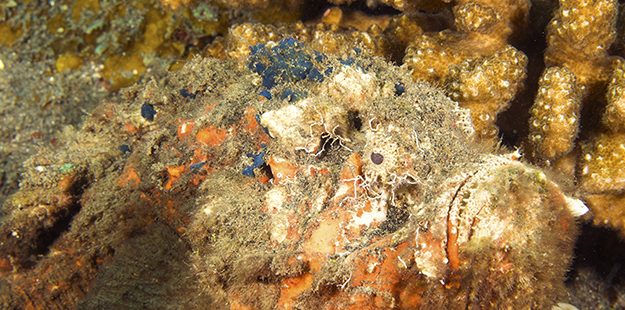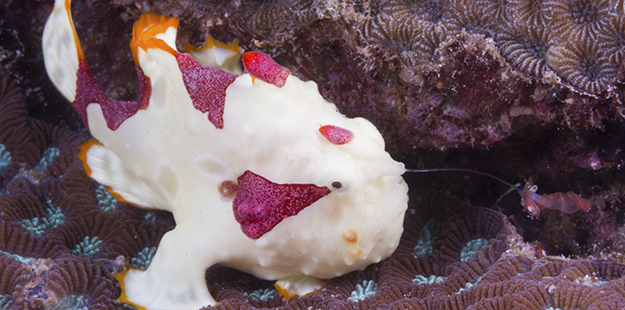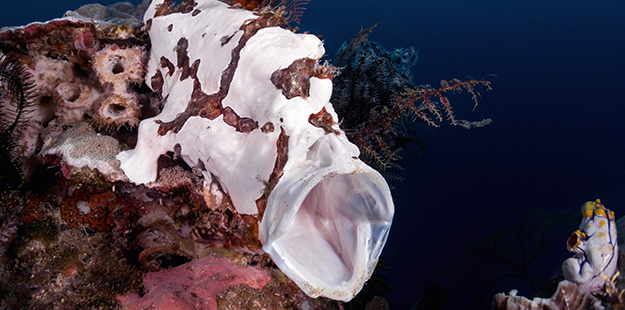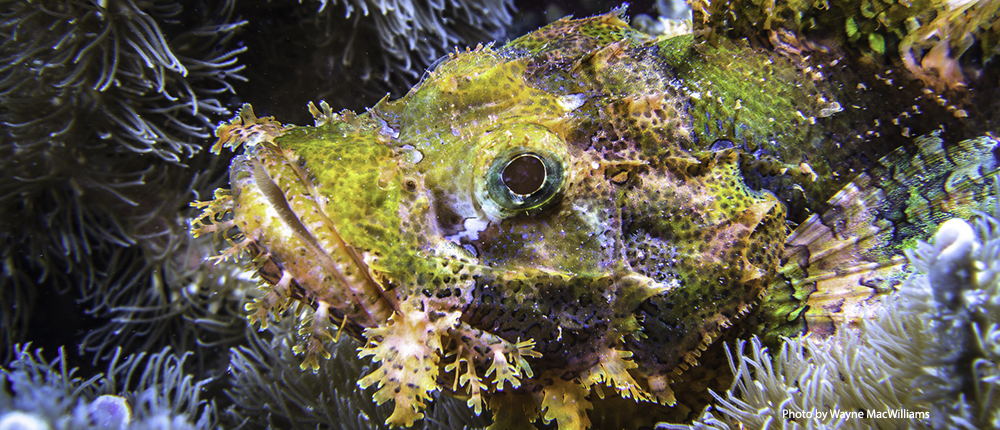Ambush Artists
When you are drifting along a sun-spangled coral slope at Wakatobi, everything may seem serene and relaxing. But in reality, the reefs are teeming with ruthless predators who lie hidden nearby, just waiting to claim their next victim. Some conceal themselves in crevices or bury themselves in debris and strike from cover, while others take on elaborate disguises that allow them to blend into the background and hide in plain sight. Fortunately, none have a taste for human flesh, mostly because we wouldn’t fit in their mouths. But most any bite-sized marine animal that ventures too close to one of these omnivorous ambushers is fair game. Here’s a revealing look at some of the stealthy ambush artists that inhabit Wakatobi’s reefs.
Striking out
With its elongated body, flattened head and mottled green/gray coloration, the crocodilefish certainly bears a resemblance to its namesake reptile. But it’s not just looks that these two ambush predators have in common. Just as a croc will lie hidden and still as a log until an antelope wanders up to the watering hole, so too will the crocodilefish blend into its surroundings and remain motionless for long periods of time. But though this fish isn’t moving, its senses remain on high alert. Should a potential meal swim within range, the crocodilefish will lunge forward with a powerful flick of its tail, engulfing the unwitting victim and swallowing it whole.

One of the evolutionary tricks that aids the crocodilefishs’ concealment are the frilly growths partially covering their eyes, which hides the gleam that could warn prey. Photo by Steve Miller
At Wakatobi, you might encounter crocodilefish in the inshore grass beds and mangroves, but they are also quite common on the reefs. These fish can alter the intensity of their coloration to match their surroundings, and they have one more evolutionary trick that aids concealment: frilly growths partially cover their eyes, breaking up the telltale gleam that might otherwise warn a wary victim.
Although the crocodilefish moves very little, its senses remain on high alert.
Discovering your first crocodilefish at Wakatobi can be an exciting moment. But as you become more familiar with the intricacies of the reef, they become easier to spot. These fish are largely indifferent to divers, and will often sit still for photographs. When they do become annoyed by human attention, they will typically pick up stakes and move to a new ambush point.
Blending in
Stonefish and scorpionfish are among the most toxic fish in the sea, but they don’t use their poisons to subdue prey. Instead, they reserve these toxic cocktails for would-be attackers, or hapless humans who make inadvertent contact with these hard-to-see hunters. To capture dinner, members of the Synanceiidae family rely on camouflage and patience. Scorpionfish generate an adaptive camouflage that allows them to blend into their surroundings. They employ a combination of color, texture and shape to create the illusion that they are just another lump of debris on the reef. When food swims within range, they will strike quickly, but with a limited range. To increase the chances of getting fed, the scorpionfish will combine lunges with suction, using a rapid expansion of their large jaws to pull the meal toward them. Scorpionfish are capable of inhaling fish up to half their own size.

Stonefish can collect a fair amount of algae growth and parasites on their skin; this added camouflage gives them a tactical advantage for ambushing prey. Photo by Walt Stearns
Stonefish take adaptive camouflage to a whole new level, morphing its body into a rounded shape that resembles a rock or lump of silt-covered coral debris. These fish are so sedentary that they may grow a coat of algae and parasites. This can aid in their camouflage, and sometimes helps lure in herbivorous prey. But when the coating gets too thick, they shed their outer skin and start over. Like the scorpionfish, stonefishes make up for limited strike ranges usually less than a quarter body length by using a very pronounced vacuum effect, explosively expanding their mouths in as little as 15 milliseconds. Stonefish have an additional tactic in their arsenal. They may burry themselves in sand or muck bottoms, leaving only their beady eyes exposed as they wait for an unsuspecting meal to swim by.
False advertising
The frogfish is nature’s ultimate couch potato. They rarely swim, and when they do move, are more likely to stump along the bottom on leg-like fins. Given their limited mobility, frogfish would stand very little chance of chasing down a meal. And so they let it come to them. But instead of simply waiting for something to swim past, they lure dinner their way using the same tricks known to fishermen the world over.

This warty frogfish’s lure, or esca, resembles a tiny shrimp, which he utilizes to tantalize and attract prey. Photo by Walt Stearns

When prey is close, the frogfish makes one of the most impressive inhales in nature, expanding its oral cavity up to twelve times its normal size. Photo by Marco Fierli, marcof8.com
An appendage known as the illicium sprouts from the frogfish’s forehead. This fishing rod supports the lure, known as the esca, which can resemble a worm, shrimp or some other marine delectable. The ruse might seem obvious, were it not for the fact that frogfish are among nature’s most perfect camouflage artists. Every aspect of their body can adapt to match surroundings. One might mimic the warty-yellow appearance of a sponge, while another sprouts hair-like growths to resemble a clump of moss. The deception works, and their angling techniques attract small crustaceans and fish. When the prey is close, the frogfish makes one of the most impressive inhales in nature. They are not the only fish that uses suction to capture a meal, but they take the technique to the highest level. In as little as 6 milliseconds, the frogfish will expand its oral cavity up to 12 times normal size, generating a powerful suction and engulfing creatures half its own size. This ability makes the frogfish one of the fastest feeding vertebrates known to science. Faster even than a teenager with a pizza.
more >


